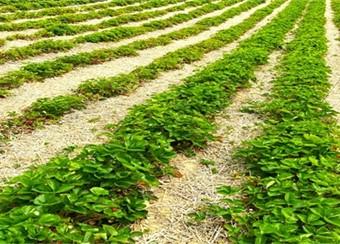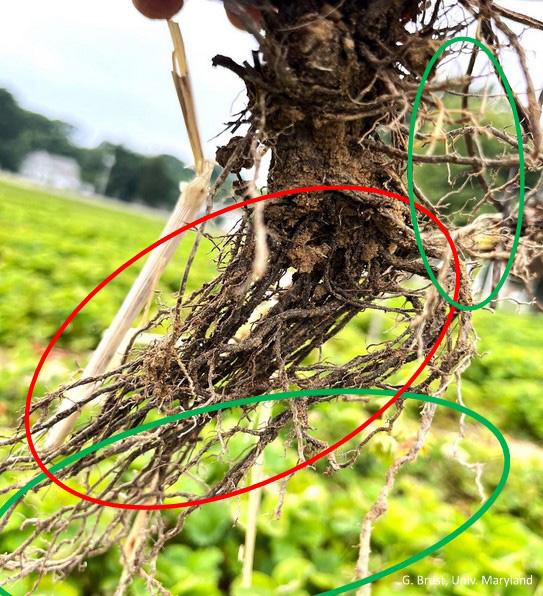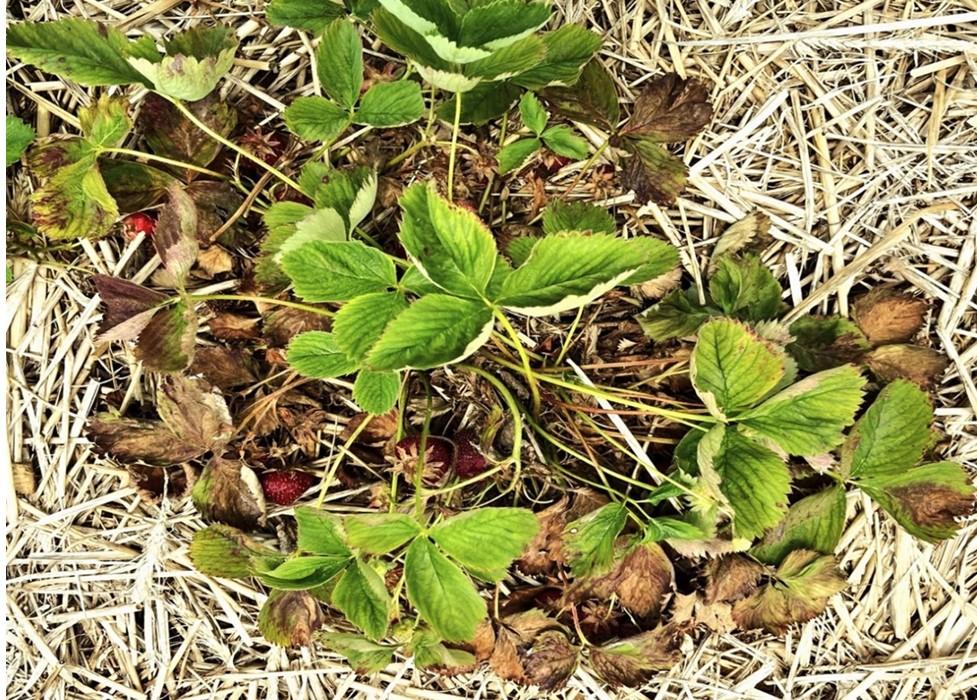Black Root Rot found in strawberry plantings
Strawberries have had a tough time of it in the Mid-Atlantic this season. Some strawberry fields have been found with black root rot disease mostly triggered, I think, by environmental stresses. Black root rot is one of those strange ‘conglomerate’ diseases that is both a serious and common problem in most strawberry producing areas. The disease gets its name because it turns the normally whitish roots of strawberry black. The disease is actually several different root disorders that produce comparable symptoms. However even these disorders are not clearly understood and are commonly known as ‘root-rot’. Not only have several different fungi been implicated as causes of black root rot, an interaction between some of the soilborne fungi and the lesion nematode has also been associated with exacerbating the disease in certain situations.

to black root rot infection then other cultivars (6 rows to left). Photo credit: G. Brust, University of Maryland
Black root rot is most common in fields that have a long history of strawberry production. In matted row systems, black root rot is generally worse in older plantings that have had limited rotations, especially during dry weather due to poor root development and when close to harvest. Infection usually begins in the first fruiting year and worsens the following years. Any type of environmental stress such as poor soil drainage, drought, flooding and soil compaction will increase the likelihood of black root rot problems.

Symptoms begin with some plants in the field showing reduced vigor and plant stunting which often occurs in low or wet spots or in portions of the field where the soil is compacted. This decline in vigor usually begins during the first fruiting year. Stunted plants often produce small fruit, few runners, and numerous dead older leaves (figure 1). Infected plants do not respond to fertilization or improved growing conditions, and yields may be reduced by 25-40%. The symptoms are most apparent the few weeks before harvest. The percentage of plants affected in a field usually increases considerably the year after symptoms first appear. Some cultivars appear to be more susceptible to infection than others (figure 2).
A good time to check plants for black root rot is when fruit begin to color. Poor looking plants should be carefully dug up and their root systems examined. If black root rot is the cause, there usually is a loss of lateral roots, and irregular black patches along the length of the roots. In severely affected plants, these black patches grow together so that only a few white roots are visible (figure 3). The interior of infected older woody roots turns black. Diagnosis of black root rot is difficult because of the many different organisms that may be involved.
Because several factors appear to be involved in the black root-rot complex, no general control method is entirely effective. While preplant fumigation of the soil before planting new strawberry plants is helpful, it is not a guarantee of success. Some horticultural methods that may help reduce black root rot’s occurrence are: Always use new plantings with healthy white-rooted plants. Rotate out of strawberries for at least 2-3 years before replanting. Minimize soil compaction and incorporate organic matter. Avoid heavy, wet soils and improve drainage in marginal soils.
This article appears in July 2023, Volume 14, Issue 5 of the Vegetable and Fruit News.
